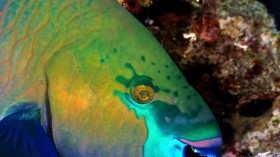Artificial insemination has been performed for the first time on the world's most endangered turtle by an international team of conservationists, providing a small ray of hope for the animal.
There are four living Yangtze giant softshell turtles (Rafetus swinhoei) remaining in existence - two in Vietnam (both thought to be males) and two in China at the Suzhou Zoo (a male and female). The male and female - both believed to be greater than 100 years of age - were brought together in 2008 as part of a captive breeding program initiated by the Turtle Survival Alliance (TSA) and the Wildlife Conservation Society (WCS) China program.
And with this captive female potentially being the last female of her species, if this artificial insemination doesn't work, it could seal the grim fate of the softshell turtle species.
"It now appears that artificial insemination is the only possible option for the pair of Rafetus swinhoei in Suzhou Zoo to reproduce successfully," Dr. Lu Shunqing, WCS China Reptile Program Director and coordinator of the Rafetus swinhoei breeding program, said in a statement. "The fate of the most endangered softshell turtle of the world is now in the balance."
Though the two turtles have before displayed courting behavior, eggs laid by the female have been infertile.
"We had to find out if the last known male in China no longer produces viable sperm due to old age or an inability to inseminate the female," said Dr. Gerald Kuchling, organizer of the artificial insemination effort and Rafetus breeding program leader for the TSA.
To determine the cause of the infertility, Suzhou Zoo, Changsha Zoo, and the China Zoo Association requested TSA assemble a team of scientists to conduct a reproductive evaluation of the male. This involved collecting semen via sedation and electro-ejaculation, since other stimulation methods did not work, and determining if he had viable sperm.
During the process, the male was determined to have damaged sex organs, perhaps due to a fight with another male decades ago.
"Normal semen parameters for Rafetus are unknown as this was the first attempt to collect and examine sperm from this species. The semen evaluation revealed that approximately half of the sperm were motile," said Dr. Barbara Durrant, Director of Reproductive Physiology at the San Diego Zoo Institute for Conservation Research.
Given these encouraging results, the research team decided to, for the first time, perform artificial insemination on the female softshell turtle. However, based on attempts with other turtle species, the odds of success don't look good. Nonetheless, the scientists wanted to explore this option since natural breeding has thus far been unsuccessful.
"This was a great exploration to advance the conservation of Rafetus swinhoei, however, we cannot yet determine if the exploration was successful or not," noted Director Chen Daqing of Suzhou Zoo.
The female will lay the eggs in a few weeks and in a couple of weeks after that, the scientists will know for sure if the eggs are fertile and if there is still hope yet for the world's most endangered turtle species.
For more great nature science stories and general news, please visit our sister site, Headlines and Global News (HNGN).
© 2024 NatureWorldNews.com All rights reserved. Do not reproduce without permission.





